
Pepsi Bottles on the Sharecropper’s Porch #1 – C. Hamsher – 2008

Pepsi Bottles on the Sharecropper’s Porch #2 – C. Hamsher – 2008
Photos taken amid the cotton fields in Bulloch County, Georgia.

Vintage Style for Modern Living

Madonna and Child – Crayon on Paper – Campbell Neil – 1965
I’ve probably studied this piece of art more than any other. I was about seven when my parents acquired and placed it in the living room of the home I grew up in. The artist, Campbell Neil, was a family friend and my father’s insurance agent. He had crafted this wonderful modern Madonna and Child using crayons and paper and this was a true wonder to me at the time. After all I had crayons, the stubs of which I carefully kept in an old Maxwell House coffee can, and this moving work of art had been made using crayons just like mine.
So I spent hours upon hours gazing at this art. I often did so with that old coffee can in front of me carefully trying to replicate just some of the beauty contained in this piece. While I didn’t, except on one or two occasions, try to replicate the subject matter I did try my hand blending the colors and began moving away from the technique used by most seven year old children of making a bold outline and then carefully coloring it in.
Looking back now this may have been the first artwork I ever fully appreciated and learned from. The depth and feeling Mr. Neil obtained using his economic lines and subtle shading had a lasting impression on me.
Campbell Neil was a kind and gentle man and these traits come across in his work. I remember when my father died in 1979 Mr. Neil was one of the first people to come to the house. He came not as my dad’s insurance agent, although he was, but he came as friend. His calmness was a welcome relief from the chaos my family was experiencing having just lost our father quite suddenly at the age of 52. We knew he shared our feeling of loss and his presence was a comfort just as the artwork he had so carefully crafted and which was hanging in the living room always had been for me.
Mr. Neil himself passed away a number of years ago but I thought of him last week as I once again studied this amazing work of art. It still hangs in my mother’s living room. It’s now a different house than the one I grew up in and in a different state but having the Madonna and Child hanging there certainly helped make it feel like home.
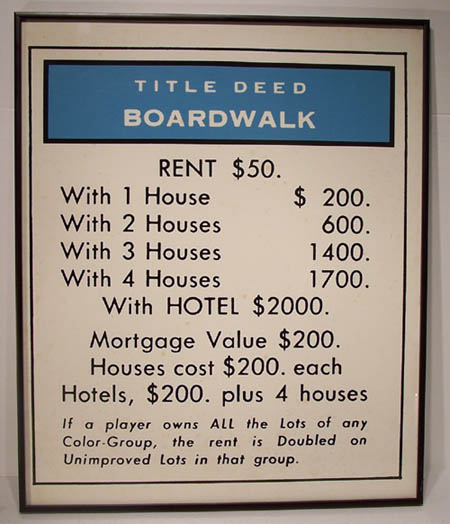
Parker Brothers Monopoly© Boardwalk Deed Poster – Image Masters Inc. – circa 1975
Late in spring photographs on the Design*Sponge blog featured the interior design of West Coast floral studio Wiggy Flowers that included a fabulous Pop Art graphic of a Monopoly© Deed on the wall. A bit nostalgic and also wonderfully modern, this bit of art triggered a discussion on the Apartment Therapy-Chicago blog on where to obtain one of these iconic images.
It seems finding one would be harder than it appears. The one shown in the Design*Sponge post had been created by Wiggy Flowers creative designer Catherine Conlin. Searches online netted little information except for two posters held by a Monopoly© collector.
I had recalled seeing these posts over the weekend while out on my usual hunt at some local estate sales when I came upon a framed Boardwalk Deed poster. Produced by Image Masters Inc. of Van Nuys, CA in the 1970’s this 24-1/4 inch by 20-1/4 inch graphic appears to be screen printed. Further digging seems to indicate this company is no longer in business.
The scarcity of these may be due to Parker Brothers tight licensing of the copyrighted graphics of the game. While the game play of Monopoly© is in public domain, the graphics used by Parker Brothers are not. It appears from markings on the piece I found that this was licensed.
As there had been considerable discussion on this topic in these other blogs I thought I’d share this find here.
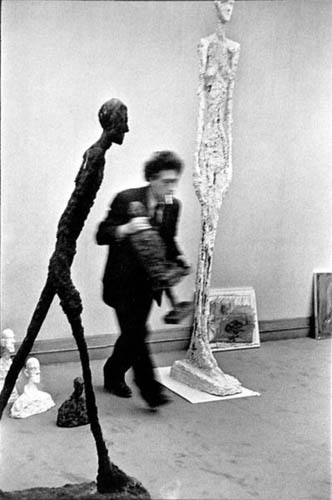
Alberto Giacometti in Studio – Henri Cartier-Bresson – circa 1952
Today marks the 100th Anniversary of the birth of photographer Henri Cartier-Bresson. I first became familiar with the work of Cartier-Bresson through some of his subjects – Picasso, Matisse, Renoir, Calder, Giacometti and Duchamp.
In 1952, Cartier-Bresson authored Images à la sauvette, whose English edition was titled The Decisive Moment. In it, he discussed the philosophy of his art by building on a concept articulated by Cardinal de Retz, “There is nothing in this world that does not have a decisive moment”
In a 1957 Washington Post interview Cartier-Bresson discussed this concept by saying:
“Photography is not like painting. There is a creative fraction of a second when you are taking a picture. Your eye must see a composition or an expression that life itself offers you, and you must know with intuition when to click the camera. That is the moment the photographer is creative. Oop! The Moment! Once you miss it, it is gone forever.”
Oop! The Moment! Once you miss it, it is gone forever.
Words as true in life as they are in art as we each face our own “decisive moments.”
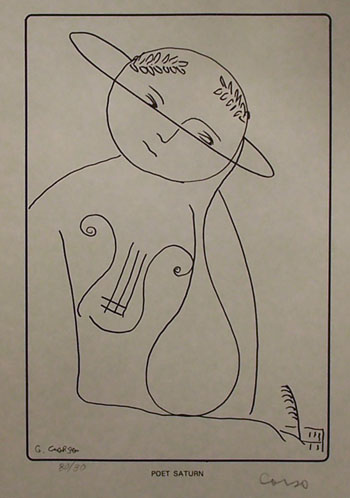
Poet Saturn – Gregory Corso – 1981
The Saturn Family series of prints was published in 1981 by The Parchment Gallery which was a venture of University of Charleston Professor William Plumley. The six piece set of signed prints were sold together as a portfolio and the edition was limited to 80. Correspondence between Corso and Plumley which I located while researching these pieces seem to indicate Corso had, at least initially, thought only one of the six was going to produced and even complained about having to sign so many.
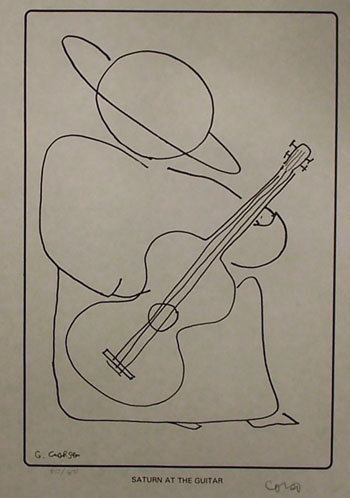
Saturn at the Guitar – Gregory Corso – 1981
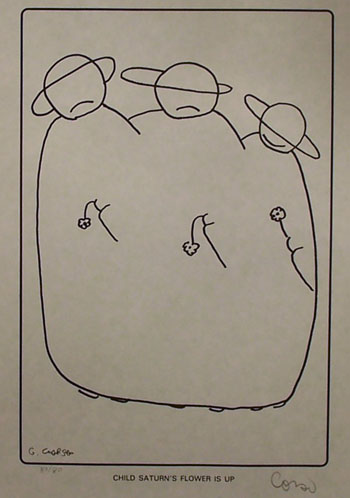
Child Saturn’s Flower is Up – Gregory Corso – 1981
According to the Academy of American Poets, Gregory Nunzio Corso was born in New York’s Greenwich Village on March 26, 1930, to teenage Italian parents. A year later, his mother moved back to Italy. After living in orphanages and foster homes, at age eleven Corso moved back in with his father, who had just remarried. After two years, however, he ran away; upon being caught he was placed in a boys’ home for two years. He was returned to his father, but after running away again was sent to Bellevue Hospital for three months “for observation.”
At age sixteen, he began a three-year sentence at Clinton State Prison for theft. While in prison, he read widely in the classics, including Dostoevsky, Stendahl, Shelley, Thomas Chatterton, and Christopher Marlowe, as well as the dictionary; it was there that he also began writing poems.
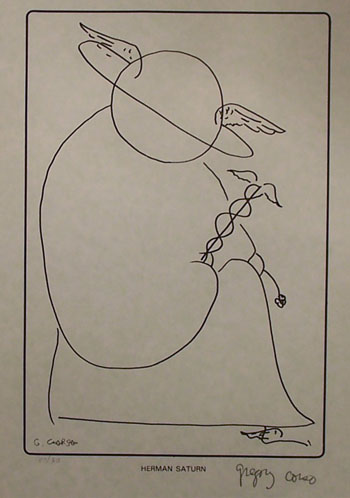
Herman Saturn – Gregory Corso – 1981
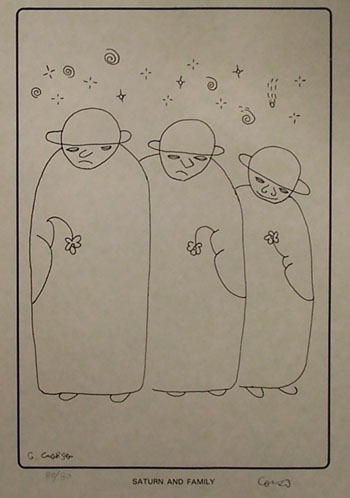
Saturn and Family – Gregory Corso – 1981
In a Greenwich Village bar in 1950, the year of his release from prison, he met Allen Ginsberg, who introduced him to experimental poetry. In 1954 he moved to Boston, where again he devoted himself to the library—this time at Harvard University. His first published poems appeared in the Harvard Advocate in 1954, and the publication of his first book, The Vestal Lady on Brattle and Other Poems (1955), was underwritten by Harvard and Radcliffe students. Corso worked at times as a laborer, a newspaper reporter for the Los Angeles Examiner, and a merchant seaman.
The following year he went to San Francisco, where he performed readings and interviews with Ginsberg and Jack Kerouac and became known as one of the major figures of the Beat movement. From 1957 to 1958 Corso lived in Paris, where he wrote many of the poems that became his book Gasoline, which Lawrence Ferlinghetti /City Lights Books published in 1958. From 1970 to 1974 Corso worked on a manuscript that was to be titled Who Am I—Who I Am, but the manuscript was stolen. He did not issue another major work until 1981’s Herald of the Autochthonic Spirit. Among other notable books are Bomb (1958), The Happy Birthday of Death (1960), Long Live Man (1962), Elegaic Feelings American (1970), and Mindfield: New and Selected Poems (1989).
Gregory Corso died on January 17, 2001, at the age of seventy.
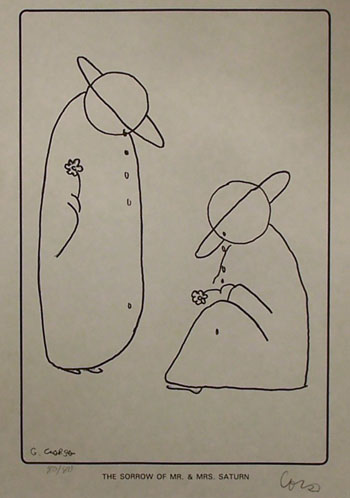
The Sorrow of Mr. & Mrs. Saturn – Gregory Corso – 1981
This rare set of prints is currently on exhibit in The Over the Moon Gallery of The Purple Moon.
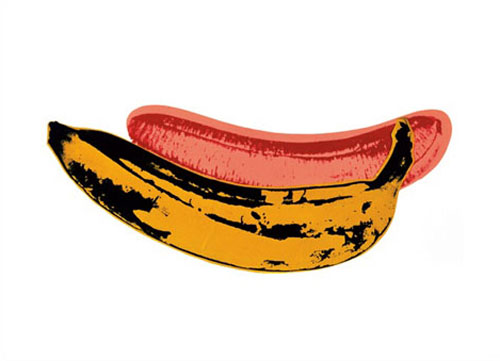
Banana – Andy Warhol – 1966
While reflecting on the work and life of Andy Warhol, who was born 80 years ago today, I got to thinking about Pop Art in general.
My first exposure to Pop Art was just before I turned 6 years old in 1964. My father was given a “gag gift” for his birthday of a plastic banana taped to piece of cardboard which had been framed. I remember he opened the gift and looked at it with a puzzled look on his face until the gift-giver told him it was a work of “pop art” and surely would be worth a fortune someday. The adults at the party all broke into laughter.
The “art” was promptly hung on the den wall where it stayed for a few years.
I loved that piece. I was as intrigued as a six year old could be as to what “pop art” was and what a banana on a piece of cardboard had to do with it. I even made a few of my own, browbeating my mother into buying me some plastic fruit at the old Bazaar Department Store in Huntington so could I make some similar works with plastic apples and even one with grapes.
While that being Pop Art (or even art) or not may be arguable. But what I was creating was certainly art to me at the time and I have never forgotten it.
It was a good number of years later before I ever heard of anyone named Andy Warhol. In fact, he painted his first banana in 1966. I am not sure my father and his friend had even heard of Warhol yet when the plastic banana art was created. I do remember being completely exstatic seeing my first Warhol banana. It immediately took me back to that old plastic banana taped to the cardboard from years before.
I guess it was Pop Art.
Anyway, that is where thinking about Andy Warhol’s birthday took me today. I wish Andy were still around – I’d send him a plastic banana.
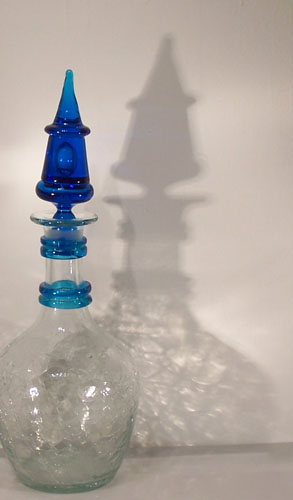
#475 Decanter – Blenko Glass – 1947
Before Winslow Anderson, Wayne Husted and Joel Myers were designing the glorious pieces during Blenko Glass’ “golden years” of the 1950’s and 60’s there was the time that has come to be known to some collectors as the “pre-designer” period. While really not true, as these pieces had to be designed by someone, it was prior to the hiring of a full-time industrial designer by the firm.
During this time most pieces were designed primarily by Richard Blenko Sr. along with his team of craftsmen. The sales department also played a role in developing items they believed would do well in the marketplace. Certainly the work coming out of the company prior to 1948 did not lack in style, imagination or beauty as can be seen in examples like the #475 decanter shown above.
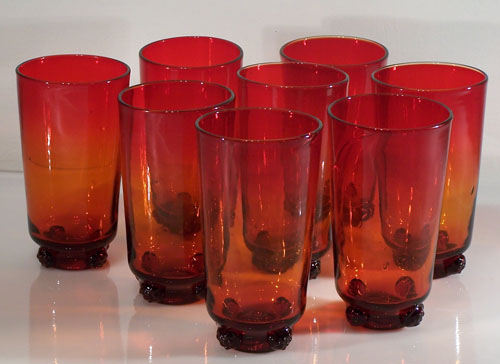
#445HB Tumbler Set – Blenko Glass – 1944
With the hiring of Winslow Anderson and the appearance of his first designs in the 1948 catalog Blenko Glass certainly saw a change in direction towards a more Scandanavian look. However it was more of an evolution than a revolution as the strength of Blenko design was there even before the first “designer” arrived. Luckily, that evolution continues through today.

Catch-It-All Detail with Better Homes & Gardens – Designer: Sol Bloom
Useful, eye-catching, sleek, graceful and oh so modern the “Catch-It-All” designed by Sol Bloom and produced by Designs for Moderns in California for a very short period beginning in 1952 epitomizes mid-century modern design for the home. This seemingly simple object is sculptural in its design and extremely functional while retaining its minimalist qualities. A true masterpiece.
Not many of these classic pieces have survived the years and they were not made for long. Records are scarce but it appears as though by 1954 or so production ceased. Many were used outdoors and lost to the elements and still others discarded over the years by owners who did not recognize the rarity, value or design significance of these “magazine holders” as many called them.
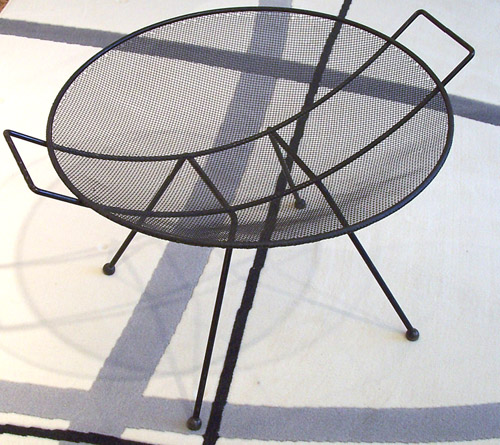
Catch-It-All – Design for Moderns – Circa 1952 – Designer: Sol Bloom
I was fortunate enough to come upon this one on trip through Pennsylvania and Virginia not too long ago. In excellent condition with no breaks to the fine metal mesh this 20th Century treasure is one of those finds which keep people like me hunting for more.

The work of Canadian glass artist David Williamson will be on display at the West Virginia Museum of American Glass in Weston beginning August 7th and will open with an artist reception and Q&A from 7 to 9 p.m.
For those unfamiliar with the WVMAG it is one of West Virginia’s true treasures and just this year moved to a bigger and better home. The museum is located at 230 Main Avenue in Weston and is open 12 – 4 p.m. most days- however they are closed on Wednesday and Sunday.
The David Williamson exhibition, Threshold Awareness, will run through December 5th.